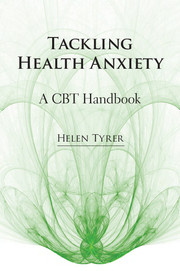Book contents
- Frontmatter
- Dedication
- Contents
- List of tables, boxes, figures and case examples
- Foreword
- Preface
- Part I Principles and practice of CBT for health anxiety
- 1 Introduction
- 2 The cognitive theory of health anxiety
- 3 Style of therapy
- 4 The initial assessment
- 5 Specific techniques
- 6 Homework: setting and evaluation
- 7 Setting goals
- 8 Relapse prevention
- 9 Troubleshooting
- Part II Presentation and aspects of management of health anxiety, by medical specialty
- References
- Index
6 - Homework: setting and evaluation
from Part I - Principles and practice of CBT for health anxiety
Published online by Cambridge University Press: 01 January 2018
- Frontmatter
- Dedication
- Contents
- List of tables, boxes, figures and case examples
- Foreword
- Preface
- Part I Principles and practice of CBT for health anxiety
- 1 Introduction
- 2 The cognitive theory of health anxiety
- 3 Style of therapy
- 4 The initial assessment
- 5 Specific techniques
- 6 Homework: setting and evaluation
- 7 Setting goals
- 8 Relapse prevention
- 9 Troubleshooting
- Part II Presentation and aspects of management of health anxiety, by medical specialty
- References
- Index
Summary
The rationale for homework
Homework is an integral part of CBT and is normally introduced from the start of therapy. Initially, it takes the form of going over the work done in the session, looking through any written material, and importantly, listening to the recording of the session, which means that ideally all sessions should be recorded. This is not essential but is a very good form of homework, particularly if patients have been very anxious in the session and not able to concentrate well. Some patients feel awkward or embarrassed listening to themselves talking about their problems, or may find it difficult finding the time, or initially be reluctant to listen to the recording, particularly if they want to listen to it alone. Nevertheless, this should always be encouraged. Hearing themselves talking about their problems can be revelatory for some patients, and as, in effect, you are going through the session again, much more information is retained. While listening to and going over any new recorded or written information remains continuous during therapy, the next phase of homework is usually an information-gathering exercise. For example, the patient may be asked to record anxiety levels at regular intervals throughout the day, while recording their activity at the time, to attempt to identify a pattern in their distress, or, typically, to evaluate the effects of checking and not checking on their health. Later on in therapy, homework is devised to test out new, alternative hypotheses that have been developed, providing first-hand experience for the patient, thereby helping to build up a body of evidence for the new hypothesis.
Throughout this handbook various examples of homework have been given, but in this section I cover how to approach the setting of this task, how to evaluate it and what to do if it does not go to plan.
Approaching the setting of homework
The homework should be relevant, purposeful and derived from what has been discussed within the therapy session, and the therapist should stress this association.
Information
- Type
- Chapter
- Information
- Tackling Health AnxietyA CBT Handbook, pp. 62 - 68Publisher: Royal College of PsychiatristsPrint publication year: 2013
